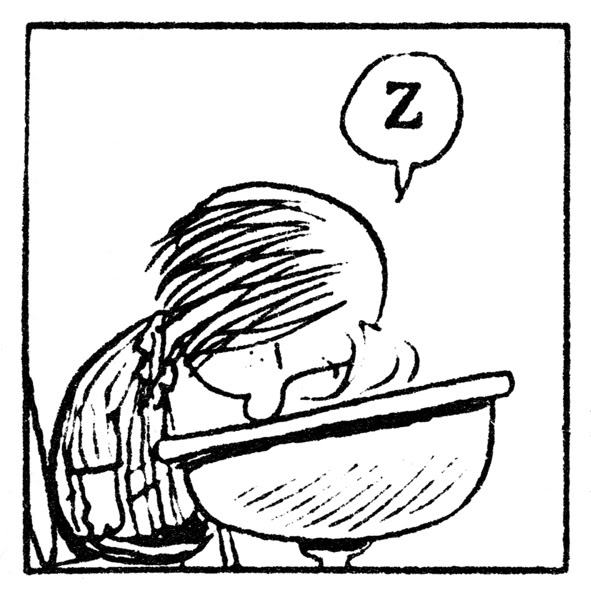The Cost of Structure
 Stay awake.
It’s a fitting message for this morning, isn’t it, when the alarm went off an hour earlier than desired? Stay awake…
Stay awake.
It’s a fitting message for this morning, isn’t it, when the alarm went off an hour earlier than desired? Stay awake…
Jesus’ message to his disciples, to stay awake, comes as they have arrived in Jerusalem. The events of the coming weeks have already begun to unfold. It is now only a matter of time before he is betrayed, arrested, tried, and executed, filling the disciples with doubt and fear. If there was any week that they might have chosen to sleep in, this is it.
Stay awake.
Our lesson this morning opens as Jesus and the disciples exit the Temple, the center of Jewish ritual and religious life. The building itself loomed large in the imagination of the people. It was actually the Second Temple to stand on that site. The first, built by King Solomon, had long ago been destroyed and the people carried off into exile. The Persian King Cyrus had freed them, sending them to Jerusalem to rebuild. What they constructed was a mere shadow of the original.
The disciples would have had all of this in mind as they took in the view. The Second Temple was a sad reminder of what once was: a powerful nation, free of foreign entanglements. Even so, the building was magnificent. We get the impression that they were like hicks in the big city, staring up in amazement at the skyscrapers towering above.
The stones had been cut from massive limestone, weighing anywhere from a few tons to 160,000 pounds each. It may not have compared to the original, but it was still quite the sight to behold. Surely nothing could be more permanent than this.
And yet, it was not to be.
The first thing Jesus tells his disciples is that these stones are nothing. They will be torn down, knocked over, such that even the mighty Jerusalem Temple would stand as a ruin – nothing more. History proved Jesus right. It was in the year 70 CE that the Romans did just that – knocked the Temple down, razed it to the ground. Even those permanent-looking 80-ton stones were demolished. They were broken down, repurposed, reused in other parts of the region. For those who saw the destruction with their own eyes, surely it must have seemed like the end of the world.
That’s the thing about the way we see the world, isn’t it? We are, by nature the extent of our years, short-sighted folk. It is hard for us to imagine things that predated us and will outlast us. In other places, there are ruins of bygone years – the pyramids of Giza, the coliseum of Rome, the temples of Machu Pichu – reminders that human history has a much larger footprint than the one that we can imagine. And yet, none of this is permanent.
We have this odd sense of the way time works. And we impose that view on the way we read the lessons of Scripture, don’t we? In some ways, it couldn’t be clearer. As Jesus paints the picture of the way it will all come to an end, he describes a world in which there are wars and rumors of wars. Nations and kingdoms will fight, he says, and earthquakes and hunger will rock the world. For more than 1500 years, people have tried to read the tealeaves, predicting that this season or that is the one that Jesus promised.
2016 is no different. You would think that we would be used to it by now, but every four years, as a presidential race ramps up yet again, we are thrown into this sense that the world is shaken to its core, that things are about to explode, erupt, and that we are on the precipice of the end of history.
But look what Jesus says: wars, natural disasters, these are just the beginning. They are nothing. We will know that things are drawing to a close not when things are unstable. Rather, we will know that things are drawing to a close when the cosmos itself begins to change. The sun turns dark, giving the moon no light to reflect. The stars and planets will appear as though they have become unmoored from their fixed spots in the heavens.
In other words, God’s timeline looks quite a bit further down the road than ours does. Just like the disciples, we might look at the grandness of our own culture and assume it is indestructible. Or when we begin to see that there might be cracks in the surface, we panic. We are cornered into fear, which is a dangerous thing. And we then project our own fear out onto the entirety of creation. In other words: if what I thought I knew was reliable is now ending, then everything must be ending.
That’s what’s hard about this faith thing – and it is what frees us, if we allow it to do so. Faith in what Jesus lived and died and rose for calls us far beyond ourselves, into this grander, universal reality of God’s eternal timeline. It lifts us above our myopic self-interest and out into the reality that, no matter what, God is at work!
For years now, we have heard predictions about the end of Mainline Protestantism. Membership numbers are on the decline. Worship attendance is down. Churches are closing, and buildings are being sold. Every year, we find something to blame for our demise. Every week, there is a dire prophecy that the “end is nigh”. Every day, there is a new “fix all” solution – if only churches and leaders were brave enough to step up.
Folks, I’ve got news: God’s future is much, much bigger than the structures we build up. God looks beyond Oglethorpe Presbyterian Church. God’s desires encompass far more than the destiny of the Presbyterian Church (U.S.A.). God’s history extends far beyond the reach of the United States of America. If we can’t say that, then our faith isn’t ultimately in God at all. Instead of believing that God has fashioned us to seek God’s desires, we have fashioned a god that suits our desires.
Look: I’m not saying that what we do is unimportant. Quite the contrary: what we do matters, and matters a great deal. That’s actually the point. Because the invitation is not to stick our heads in the sand and wait for the inevitable collapse of society. Instead, the invitation is to pay attention and to respond in faith.
A farmer sees the leaves change and knows that summer is just around the corner. A servant sees the owner returning down the road and knows it is time to get the house in order. If we stay awake, if we are alert, aware, attentive to the world around us and beyond it, then, sure: we will know when all of this is really coming to an end. But more importantly, we will be in tune with what it is that God is calling us to do in the here and now.
After all, God is not just God of the past. And God is not just God of the future. God is God of the present. That’s what this incarnate faith of ours reminds us: God chose flesh. God chose to be embodied. God chose to become material in Jesus. Because this stuff matters!
The tension of faith is what it means to live as though it matters while keeping that greater, divine perspective intact. Yes: there are wars. Yes: there are rumors of wars. Yes: there are pretenders to faithful leadership. Yes: there are nations rising and collapsing and earthquakes and floods and destruction and death and violence. And: we are still called to faithfulness in the midst of it all.
When there is war, we are the peacemakers. When there are those who preach false gospels, we speak – and live – the truth in love. When there is hunger, we feed. When the world is shaken, we extend a steady hand.
And when we seek war, we trust that the peacemakers will stand in the way. When we preach false gospels, we hope for the wisdom to hear those who tell us the loving truth. When we are hungry, we know that we will be fed. When our world is shaken, we depend on God’s steady presence.
And in all of this, we keep the true lesson of history in mind: in all of human history, there has never been a time of perfect faithfulness. Even the Garden of Eden was nothing more than a flash in the pan. We don’t look back to find the blueprint for looking forward. Instead, we look back to learn from those who have, in each time and in every place, followed the call to faithful living, giving God’s desires shape and form and breath and life. And in so doing, we learn something about what it means to be faithful in this time and place, as well as in the days to come, whatever they may bring.
This, friends, as we say each and every week, is the truth of the gospel: in Jesus Christ, we are forgiven. May our lives be living examples of this faith, mirroring the grace we receive and reflecting it out onto this broken, hurting, and fleeting world – today, tomorrow, and all the days to come.
Amen.
